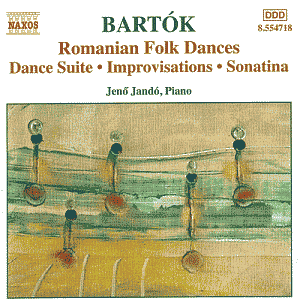Having not come across Volume 1 of this series, I was
intrigued to hear the second instalment of Naxos’s (presumably) complete
survey of Bartók’s piano music. Like some of their other ongoing
series’ (Schubert Lieder, Liszt piano music, The Eighteenth Century
Symphony etc.), it comes into direct competition with one of the major
labels, in this case the award-winning Philips series from Jandó’s
fellow Hungarian Zoltan Kocsis. Previous Bartók recitals from
Andor Foldes and Gyorgy Cziffra carried the authenticity of close association
with the composer (not forgetting some of Bartók’s own forays
into the studio), but by any standards the Kocsis series has become
a benchmark in terms of pianism, recording quality and adherence to
Bartók’s instructions (we know Kocsis studied some of those early
recordings to get a fuller picture of the composer’s intentions). All
in all, a hard act to follow.
It is to Jandó’s credit that one can safely
listen to his performances and not feel the need to make those ’odious
comparisons’ so beloved of critics. In fact admirers of the ubiquitous
Naxos ‘in-house’ pianist can rest assured that Jandó is very
much on home territory here, as indeed he proved to be previously when
accompanying Gyorgy Pauk and Kalman Berkes on a superb disc of the Bartók
Violin Sonatas and Contrasts (Naxos 8.550749).
As to the music itself, every item (like virtually
all Bartók’s piano music) is folk-inspired. His ethnomusicological
researches with Kodaly are well documented, and of course the results
found their way into all his mature works. But as a gifted pianist,
it was almost inevitable that his keyboard output would reflect his
findings as fully as any of his other compositional areas.
All the pieces are in the form of suites or collections
of short items (some very short-35 seconds!), and the first may well
be the most intriguing of all to those who know Bartók’s output,
a piano arrangement of the famous Dance Suite for orchestra. The original
was written in 1923 to celebrate the union of the cities of Buda and
Pest into the present-day Hungarian capital. The piece’s subtle interplay
of Magyar dances, traditional Romanian melodies from the Wallachian
region, and exhilaratingly infectious rhythmic ostinatos immediately
made an impact and the suite established itself as one of Bartók’s
most popular pieces. The piano arrangement was made at the suggestion
of Emil Hertzka, director of the Viennese publisher Universal, who asked
for something 'not too difficult’. In fact the resulting transcription
is probably as difficult as anything in his output, and although Bartók
apparently never included it in a recital, it was enthusiastically taken
up by, amongst others, Geza Anda and the man who gave the first public
performance, Gyorgy Sandor.
Anyone familiar with the orchestral version may at
first miss the quirkily characteristic woodwind writing (as in the wistful
ritornello theme that links the six movements) or the swooping trombone
glissandi , an effect Bartók used from his savage early pantomime
The Miraculous Mandarin through to his last completed work, the Concerto
for Orchestra. No one need fear; in Jandó’s expert hands the
orchestra is forgotten. His acutely observed performance shows a marvellously
controlled vitality, and the necessary rhythmic attack never becomes
aggressive, an easy mistake in Bartók (the composer’s own recordings
amply demonstrate that beauty of tone and legato lyricism were as important
to him as the percussive nature of the piano). If Kocsis’s version finds
a shade more colour and contrast, Jandó’s is as viable in its
restraint and thoughtfulness.
In some ways a more significant piece follows in the
shape of the 8 Improvisations on Hungarian Peasant Songs Op. 20. This
dates from 1920 and was the last piece to which Bartók gave an
opus number, confirming from now on his ‘art’ and folk-derived compositions
were to enjoy equal status. As he pointed out ‘… the used folk melody
is to be regarded only as a motto, on which an … independent music can
be created.' The result is a thoroughly typical mix of abrasive, pounding
dissonance (that also harks back to the Mandarin), rhythmic syncopation
and a truly improvisatory feel that looks ahead to the violin sonatas.
The seventh of the set, interestingly, was Bartók’s contribution
to the memorial supplement of ‘ La Revue musicale’, published in December
1920 in honour of a composer he greatly admired, Debussy. Jandó
again rises to the occasion with playing of great subtlety and wit.
The rest of the recital is made up of what might be
termed ‘creative transcriptions’, the most interesting of which is the
Petite Suite. This is actually made up of piano arrangements of six
of the 44 Duos for Two Violins, made in 1937, five years after the original.
Again the Bartók ‘thumbprints’ are everywhere, with No. 4, entitled
‘Quasi Pizzicato’ being a particularly ingenious transcription into
keyboard terms of the idiomatic string technique.
Jandó despatches all these works by his great
predecessor with a panache and virtuosity that are wholly captivating
and well up to the pianist’s own high standards. His superbly regulated
instrument is well caught by the engineers and the recording venue is
better than some from this source. A series to watch with interest,
regardless of the famously tempting Naxos price.
Tony Haywood


